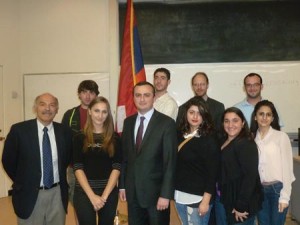Marine Vardanyan
Staff Writer

February 20, 1988, marks a moment in Armenian history when the people of Armenia and Karabagh utilized their willpower to protest and demand the independence of Karabagh from Azerbaijan and its unification with Armenia. That date gave birth to the Karabagh Liberation Movement and was the first drop of the ripple effect that continues to touch the lives of Armenians until today.
This year marks the 25th anniversary of the Karabagh Liberation Movement, and to mark the occasion the Fresno State Armenian Studies Program, in collaboration with the Armenian National Committee of America, Central California Chapter, organized a lecture by the Permanent Representative of the NKR to the United States, Robert Avetisyan. The event took place on March 22, 2013, in McLane Hall, Room 121, with representatives for Congressmen Devin Nunes and Jim Costa in attendance.
To begin the evening, Armenian Studies Program Coordinator Barlow Der Mugrdechian welcomed guests. Paul Jamushian, on behalf of the ANC, stressed the importance of informing a broad audience about the Karabagh movement. Prof. Der Mugrdechian then introduced Avetisyan, who has served as the Karabagh Representative in Washington, D.C. since 2009.
Avetisyan discussed the years of conflict with Azerbaijan, beginning from the early 20th century following the collapse of the Russian Empire, after which Azerbaijan claimed Karabagh. Karabagh was recognized as part of Armenia in 1921, but Joseph Stalin later changed this decision and placed Karabagh under Azeri administration. Over the years, the Armenians in Karabagh faced challenges in economic development, due to obstacles by the Azerbaijani government, and the Armenian culture and history were endangered.
When the Karabagh began to legally call for unification with Armenia, in February of 1988, hundreds of miles away in Sumgait, Azerbaijan, the Azeris organized a pogrom against the Armenians. “The Armenian minority was murdered and subject to inhumane tortures—just for being Armenian,” stated Avetisyan.
Following a referendum in 1988, and attacks by Azerbaijan, the Karabagh War began, with young soldiers, along with volunteers from our own Central Valley, joining the fight to defend their land. The war had a devastating effect on Karabagh, but the people of Artsakh (historical name for Karabagh) have since recovered, bringing about progress and development that can be seen today.
The constant threats and aggression from Azerbaijan have not been successful in disturbing the positive direction in which Karabagh is now heading. Avetisyan explained the great advances that are taking place in the region. NKR is now exploring new economic opportunities and is developing its infrastructure. The country now is able to provide about 70% of its own electricity. With many projects underway, such as a high-end hotel in Stepanakert, the Republic of Karabagh has demonstrated that their goals can be achieved, despite its hostile neighbor.
Robert Avetisyan’s visit to Fresno was not only to celebrate the 25th anniversary of the Karabagh Liberation Movement, but to also share with the audience the years of adversities and accomplishments experienced.
Mark Samoulian, who visited Artsakh in 2012, commented “Attending the NKR lecture with Robert Avetisyan was truly a privilege. It felt good to be updated and informed about news and current events within our beautiful Karabakh.”
Avetisyan spoke of NKR’s history, modern-day conditions, and then responded to various questions from the eager audience. During his presentation, Avetisyan was also awarded a plaque from Congressman Costa, with the Congressman’s statement on the 25th Anniversary of the Liberation Movement.
Avetisyan concluded by reemphasizing the perseverance of the people of Karabagh and invited everyone to visit the beautiful region.
“The sincerity you’ll meet in Artsakh is unique to only this piece of land.”
 Hye Sharzhoom Armenian Action
Hye Sharzhoom Armenian Action